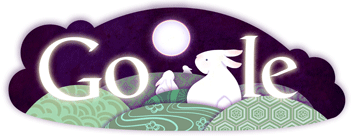Happy Halloween
By clicking on the Google logo, users can view a series of Halloween 2009-themed images before being directed to a results page.
The logo initially appears grey with the letter "e" in the shape of a pumpkin. One click and the Halloween 2009 logo is transformed to show sweets making the shape of each letter. The pile of sweets gets bigger with a second click, while a third shows only the sweet wrappers remaing as if someone has eaten the horde.
The logo initially appears grey with the letter "e" in the shape of a pumpkin. One click and the Halloween 2009 logo is transformed to show sweets making the shape of each letter. The pile of sweets gets bigger with a second click, while a third shows only the sweet wrappers remaing as if someone has eaten the horde.
 |
| Source: http://www.google.com/logos/clickortreat1.gif |
 |
| Source: http://www.google.com/logos/clickortreat2.gif |
 |
| Source: http://www.google.com/logos/clickortreat3.gif |
 |
| Source: http://www.google.com/logos/clickortreat4.gif |
Halloween 2009
Google Logo - Halloween 2009
Halloween (also spelled Hallowe'en) is an annual holiday celebrated on October 31. It has roots in the Celtic festival of Samhain and the Christian holy day of All Saints. It is largely a secular celebration but some have expressed strong feelings about perceived religious overtones.
The day is often associated with the colors black and orange, and is strongly associated with symbols like the jack-o'-lantern. Halloween activities include trick-or-treating, wearing costumes and attending costume parties, ghost tours, bonfires, visiting haunted attractions, pranks, telling scary stories, and watching horror films.
via wiki
Asterix Comic's 50th Anniversary
 |
| © 2009 Goscinny - Uderzo Source: http://www.google.com/logos/asterix09.gif |
29 Ekim Cumhuriyet Bayramı
Google Turkey Logo - 29 Ekim Cumhuriyet Bayramı
Bayram is the Turkiс word for a nationally celebrated festival or holiday, applicable to both national (i.e. secular) or religious celebrations. In accordance with this dual applicability, the method with which one determines the yearly timing of Bayrams is different for national and religious holidays.
29 Ekim Cumhuriyet Bayramı, Türkiye Cumhuriyeti'nin ilanı anısına her yıl 29 Ekim günü Türkiye ve Kuzey Kıbrıs'ta[1] kutlanan ulusal bayramdır.
via wiki
Astérix et Obélix
Google France Logo - Astérix et Obélix
The Adventures of Asterix (French: Astérix or Astérix le Gaulois) is a series of French comic strips written by René Goscinny and illustrated by Albert Uderzo (Uderzo also took over the job of writing the series after the death of Goscinny in 1977). The series first appeared in French in the magazine Pilote on 29 October 1959. As of 2008, 33 comic books in the series have been released.
Astérix le Gaulois est une série de bande dessinée française, créée le 29 octobre 1959 par René Goscinny (scénario) et Albert Uderzo (dessins puis, à partir de 1980, scénario et dessins) dans Pilote. Il s'agit certainement de la bande dessinée française qui a connu le plus de succès, avec 325 millions d'albums vendus dans le monde en 47 ans.
via wiki
National Day of Austria
Google Austria Logo - National Day (Nationalfeiertag Österreich)
Der österreichische Nationalfeiertag wird seit dem Jahr 1965 jährlich am 26. Oktober begangen. Damals wurde der frühere Tag der Fahne in den nunmehrigen Nationalfeiertag umbenannt. Im Jahr 1967 wurde dieser Tag den übrigen gesetzlichen Feiertagen in Österreich gleichgestellt und ist seither arbeitsfrei.
Mei Lanfang's Birthday
 |
| Source: http://www.google.com/logos/meilanfang09.gif |
Mei Lan Fang 梅兰芳诞辰115周年
Google China Logo - Mei Lan Fang 梅兰芳诞辰115周年
Mei Lanfang (simplified Chinese: 梅兰芳; traditional Chinese: 梅蘭芳; pinyin: Méi Lánfāng) (October 22, 1894 – August 8, 1961) was one of the most famous Beijing (Peking) opera artists in modern history, exclusively known for his qingyi roles, a type of dan role. Méi Lánfāng is his stage name, and in Chinese it is generally considered a feminine name. His real name was Méi Lán (simplified Chinese: 梅澜; traditional Chinese: 梅瀾). Mei, Shang Xiaoyun (尚小云), Cheng Yanqiu (程砚秋) and Xun Huisheng (荀慧生) were known as Four Great Dan in the golden era of Peking Opera.
梅兰芳,名澜,字浣华,原籍江苏泰洲(今改为县),1894年出生在北京的京剧梨园世家。他的祖父梅巧玲是“同光十三绝”之一,著名旦角演员;他的父亲梅竹芬早年演老生,后演小生,最后改青衣,生前也是颇有名气的旦角演员。梅兰芳从小受到京剧的熏陶,拜了不少名师,他8岁就登台演戏,20岁已蜚声南北,25岁出国献艺。他1919年至1935年先后到日本、美国、苏联演出,第一个把中国的京剧艺术传播到海外去,成为饮誉中外的京剧艺术大师。
via wiki
Rampo Edogawa's Birthday
 |
| Source: http://www.google.com/logos/rampo09.gif |
Edogawa Rampo 江戸川 乱歩
Google Japan Logo - Edogawa Rampo 江戸川 乱歩
Tarō Hirai (平井 太郎 Hirai Tarō?, October 21, 1894 - July 28, 1965), better known by the pseudonym Edogawa Rampo (江戸川 乱歩 Edogawa Ranpo?, usually romanized as "Edogawa Rampo"), was a Japanese author and critic. He wrote many works of detective fiction. Kogoro Akechi was the primary detective of these novels.
Rampo was an admirer of western mystery writers, and especially of Edgar Allan Poe. His pseudonym is actually a Japanese rendering of Poe's name. Other authors who were special influences on him were Maurice Leblanc and Sir Arthur Conan Doyle.
江戸川 乱歩(えどがわ らんぽ、正字体:江戸川 亂步、男性、明治27年(1894年)10月21日 - 昭和40年(1965年)7月28日)は、大正から昭和期にかけて主に推理小説を得意とした小説家・推理作家である。また、戦後は推理小説専門の評論家としても健筆を揮った。
本名は平井 太郎(ひらい たろう)。筆名はアメリカの文豪エドガー・アラン・ポーをもじったものである。日本推理作家協会初代理事長。位階は正五位。勲等は勲三等。
via wiki
Mikhail Lermontov's Birthday
 |
| Source: http://www.google.com/logos/lermontov09.gif |
| Mikhail Lermontov in 1837 |
Mikhail Yuryevich Lermontov
Google Russia Logo - Mikhail Yuryevich Lermontov
Mikhail Yuryevich Lermontov (Михаи́л Ю́рьевич Ле́рмонтов Russian), (October 15 [O.S. October 3] 1814 – July 27 [O.S. July 15] 1841), a Russian Romantic writer, poet and painter, sometimes called "the poet of the Caucasus", was the most important Russian poet after Alexander Pushkin's death. His influence on later Russian literature is still felt in modern times, not only through his poetry, but also by his prose. His poetry remains popular in Chechnya, Dagestan, and beyond Russia.
Михаи́л Ю́рьевич Ле́рмонтов (3 (15) октября 1814, Москва — 13 (27) июля 1841, Пятигорск) — русский поэт, прозаик, драматург, художник, офицер.
Teacher's Day
 |
| Source: http://www.google.com/logos/teachersday09.gif |
Polish Teacher's Day
Google Poland Logo - Teacher's Day
Dzień Edukacji Narodowej – polskie święto branżowe oświaty i szkolnictwa wyższego obchodzone 14 października, w rocznicę powstania Komisji Edukacji Narodowej (KEN), utworzonej z inicjatywy króla Stanisława Augusta Poniatowskiego na mocy uchwały Sejmu Rozbiorowego z dnia 14 października 1773 roku.
150 Years Since Multatuli
 |
| Source: http://www.google.com/logos/multatuli09.gif |
150 anniversary of Max Havelaar
Google Nederland logo - 150 anniversary of Max Havelaar
Max Havelaar: Or the Coffee Auctions of the Dutch Trading Company (Dutch: Max Havelaar, of de koffij-veilingen der Nederlandsche Handel-Maatschappij) is a culturally and socially significant 1860 novel by Multatuli (the pen name of Eduard Douwes Dekker) which was to play a key role in shaping and modifying Dutch colonial policy in the Dutch East Indies in the nineteenth and early twentieth century. In the novel, the protagonist, Max Havelaar, tries to battle against a corrupt government system in Java, which was a Dutch colony at the time.
via wiki
Brazilian Children's Day
Google Brazil Logo - Children's Day
In Brazil, Children's Day is celebrated on October 12, coinciding with Our Lady of Aparecida's day, the country's Patron Saint, which is a national holiday.
Canadian Thanksgiving 2009
Google Canada Logo - Canadian Thanksgiving 2009
Thanksgiving, or Thanksgiving Day (Canadian French: Jour de l'Action de grâce), occurring on the second Monday in October, is an annual Canadian holiday to give thanks at the close of the harvest season. Although the original act of Parliament references God and the holiday is celebrated in churches, the holiday is also celebrated in a secular manner.
On January 31, 1957, the Canadian Parliament proclaimed:
“ A Day of General Thanksgiving to Almighty God for the bountiful harvest with which Canada has been blessed … to be observed on the 2nd Monday in October. ”
via wiki
Giuseppe Verdi's Birthday
 |
| Source: http://www.google.com/logos/verdi09.gif |
| Giuseppe Verdi. Portrait by Giovanni Boldini, 1886 |
Giuseppe Verdi's Birthday
Google Italy Logo - Giuseppe Verdi's Birthday
Korean Hangul Proclamation Day - 한글날
Google Korea Logo - Hangul Proclamation Day - 한글날
Hangul Day — also called Hangul Proclamation Day or Korean Alphabet Day — is a Korean national commemorative day marking the invention and the proclamation of hangul (한글), the native alphabet of the Korean language, by King Sejong the Great. It is observed on October 9 in South Korea and on January 15 in North Korea. In North Korea the day is called Chosŏn'gŭl Day.
한글날은 세종대왕이 훈민정음을 반포한 것을 기념하기 위한 날이다. 대한민국에서는 10월 9일이다. 조선민주주의인민공화국에서는 1월 15일에 조선글날을 기념한다.
이 날에 대한민국에서는 국기인 태극기를 단다.
Invention of the Bar Code
Google’s new logo is a barcode which, as far as we can tell, says “Google.” Today is the 57th anniversary of the first patent on the bar code. Inventors Norman Woodland and Bernard Silver filed the patent on October 1949, and it was granted, No. 2,612,994, on October 7, 1952. The original patent was for a system that would encode data in circles (a bulls eye pattern), so that it could be scanned in any direction.
The barcode on the Google homepage is Code 128 encoded, which is a standard way of encoding ASCII character strings (ie. A-Z, a-z, 0-9, etc.) into a barcode. It would be safe to assume that Google used their own open source barcode project, ZXing, to generate the barcode. The same library is used in Android for barcode recognition.
A barcode is an optical machine-readable representation of data, which shows certain data on certain products. Originally, barcodes represented data in the widths (lines) and the spacings of parallel lines, and may be referred to as linear or 1D (1 dimensional) barcodes or symbologies. They also come in patterns of squares, dots, hexagons and other geometric patterns within images termed 2D (2 dimensional) matrix codes or symbologies. Although 2D systems use symbols other than bars, they are generally referred to as barcodes as well. Barcodes can be read by optical scanners called barcode readers, or scanned from an image by special software.
The first use of barcodes was to label railroad cars, but they were not commercially successful until they were used to automate supermarket checkout systems, a task in which they have become almost universal. Their use has spread to many other roles as well, tasks that are generically referred to as Auto ID Data Capture (AIDC). Other systems are attempting to make inroads in the AIDC market, but the simplicity, universality and low cost of barcodes has limited the role of these other systems. It costs 0.5¢ (U.S.) to implement a barcode, while passive RFID still costs about 7¢ to 30¢ per tag. [Read more on Wikipedia]
The barcode on the Google homepage is Code 128 encoded, which is a standard way of encoding ASCII character strings (ie. A-Z, a-z, 0-9, etc.) into a barcode. It would be safe to assume that Google used their own open source barcode project, ZXing, to generate the barcode. The same library is used in Android for barcode recognition.
 |
| http://www.google.com/logos/barcode09.gif |
The first use of barcodes was to label railroad cars, but they were not commercially successful until they were used to automate supermarket checkout systems, a task in which they have become almost universal. Their use has spread to many other roles as well, tasks that are generically referred to as Auto ID Data Capture (AIDC). Other systems are attempting to make inroads in the AIDC market, but the simplicity, universality and low cost of barcodes has limited the role of these other systems. It costs 0.5¢ (U.S.) to implement a barcode, while passive RFID still costs about 7¢ to 30¢ per tag. [Read more on Wikipedia]
Invention of The Barcode
Google logo - Invention of The Barcode
Google released a barcode logo today, we run the geometric patterns on Android, not surprisingly, the result found is plain text "Google", please see the image below:
A barcode (also bar code) is an optical machine-readable representation of data. Originally, bar codes represented data in the widths (lines) and the spacings of parallel lines, and may be referred to as linear or 1D (1 dimensional) barcodes or symbologies. They also come in patterns of squares, dots, hexagons and other geometric patterns within images termed 2D (2 dimensional) matrix codes or symbologies. Although 2D systems use symbols other than bars, they are generally referred to as barcodes as well.
Moon Viewing Day (Tsukimi)
 |
| Source: http://www.google.com/logos/moonja09.gif |
Japanese Tsukimi Festival
Google Japan Logo - Tsukimi Festival
Tsukimi (月見), (sometimes written as Otsukimi) literally moon-viewing, refers to Japanese festivals honoring the autumn moon. The celebration of the full moon typically takes place on the 15th day of the eighth month of the traditional Japanese lunisolar calendar; the waxing moon is celebrated on the 13th day of the ninth month. These days normally fall in September and October of the modern solar calendar.
The Tsukimi custom was originally borrowed from the Chinese Mid-Autumn Festival. The tradition is now so popular in Japan that some people repeat the activities for several evenings following the appearance of the full moon during the eighth lunisolar month.
月見(つきみ)とは、満月など月を眺めて楽しむこと。観月(かんげつ)とも言う。
月見(お月見)とは、旧暦の8月15日と9月13日に月を鑑賞することである。前者の夜を「十五夜」、後者の夜を「十三夜」と呼ぶ。十五夜の月は、サトイモなどを供えることが多いため「芋名月」とも呼ばれる。一方、十三夜の月は、栗や豆を供えることが多いため「栗名月」又は「豆名月」とも呼ばれる。どちらか一方の月見だけをすることは、「片見月」として嫌われた。十五夜の月を鑑賞する習慣は中国から伝わったが、十三夜の月見は日本独特の風習であり、平安時代に貴族たちが集まって、月を見て詩歌を詠んだのが始まりといわれる。十五夜の月は「中秋の名月(ちゅうしゅうのめいげつ)」とも呼ばれる[1]。
十五夜のグレゴリオ暦(新暦)での該当日はこちらの対照表を参照。
via wiki
Korean Chuseok
Google Korea Logo - Chuseok
추석(秋夕)은 한가위, 중추, 중추절, 가배일로 부르기도 하며, 음력 8월 15일에 치르는 명절로서 설날 다음으로 한국인에게 전통적으로 깊은 뜻을 지니고 있는 한국의 전통적인 명절이다. 가을 추수를 끝내고 햅쌀과 햇과일로 조상들께 감사의 마음으로 차례를 지내며, 특히 송편은 추석에 먹는 별미로 들 수 있다. 추석에는 고향을 방문하는 전통이 있다. 이때문에 전국민의 75%가 고향을 방문하여 추석이 되면 전국의 고속도로가 정체되고 열차표가 매진되는데, 이러한 현상을 '민족대이동'이라 부르기도 한다.
대한민국에서는 추석 전날과 다음날까지 3일이 공휴일이다. 단, 일요일이 연휴와 겹치더라도 공휴일이 연장되지 않는다.
via wiki
Mid Autumn Day 中秋节
Google China Logo -Mid Autumn Day 中秋节
The Mid-Autumn Festival, also known as the Moon Festival, or in Chinese, Zhongqiu Jie (traditional Chinese: 中秋節), is a popular harvest festival celebrated by Chinese people, Japanese people (Tsukimi festival in Japanese), Koreans (Chuseok festival in Korean), and Vietnamese people (even though they celebrate it differently), dating back over 3,000 years to moon worship in China's Shang Dynasty. It was first called Zhongqiu Jie (literally "Mid-Autumn Festival") in the Zhou Dynasty. In Malaysia, Singapore, and the Philippines, it is also sometimes referred to as the Lantern Festival or Mooncake Festival.
The Mid-Autumn Festival is held on the 15th day of the eighth month in the Chinese calendar, which is usually around late September or early October in the Gregorian calendar. It is a date that parallels the autumn and spring Equinoxes of the solar calendar, when the moon is supposedly at its fullest and roundest.
中秋节起源于中国,是东亚民间的一个传统节日,为每年农历的八月十五。中秋节不单单是华人的节日,受中华文化的影响,中秋节也是日本、越南、朝鲜半岛等地的传统节日。
按照中国的农历,八月为秋季的第二个月,古时称为仲秋,因此民间称为中秋,又称秋夕、八月节、八月半、月夕、月节,又因为这一天月亮满圆,象征团圆,又称为团圆节。
via wiki
Mahatma Gandhi's Birthday
 |
| Source: http://www.google.com/logos/gandhi09.gif |
Subscribe to:
Comments (Atom)




































